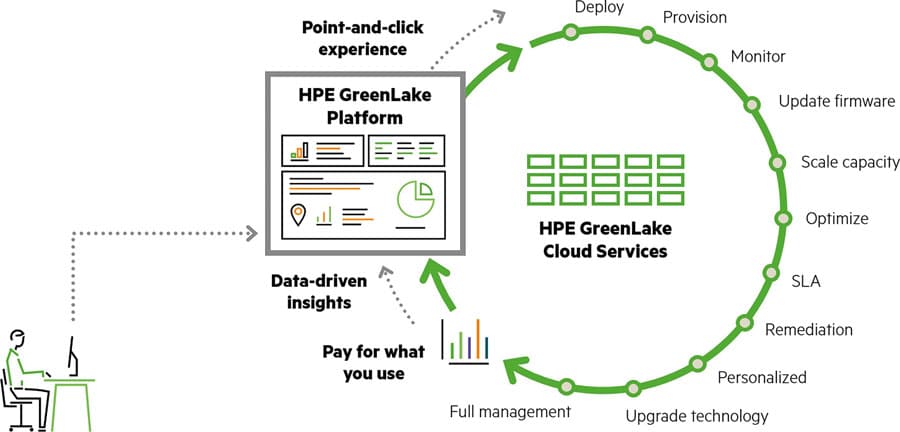The cloud in your own data center


Oettinger Davidoff runs its SAP Hana applications on the HPE GreenLake platform
After one year of operation, it has been confirmed that it was the right choice. Last year in 2022, the appliances on which Oettinger Davidoff, the world's leading manufacturer of handmade premium cigars, had operated its SAP applications for six years reached the end of their lifecycle.
Just a few years ago, the decision for a successor system would have been relatively easy. There were the alternatives of an appliance solution and a tailored data center integration, and the offer with the best price-performance ratio would have won the bid.
This time, however, the SAP team at Oettinger Davidoff "opened the fan wider," as project manager Josef Huber puts it. This was because new alternatives had become established in the meantime - such as infrastructure services from the public cloud or SAP Rise, which is also cloud-based.
To go or to stay?
So for Josef Huber's team, it wasn't just a matter of selecting a system, but also the crucial question: Should we go or stay? Should we outsource our SAP Hana applications to the public cloud or continue to operate them in our own data center? In addition to SAP Rise, a variant with a local IT service provider was also examined, which would have taken over the migration and operation at a hyperscaler.
Actually, the migration to the public cloud would have been a logical and necessary step, because the operation of the Linux-based system landscape was increasingly pushing the SAP team at Oettinger Davidoff to the limits of its capacities. With the cloud migration, they would have been able to get rid of this burden and concentrate fully on the applications and business processes.
But there were a number of obstacles in the way. For example, the Rise options were not a competitive option for a licensing model that simply did not fit for Oettinger Davidoff, a family-owned company with around 3300 employees worldwide and sales of around 450 million Swiss francs.
In addition, fundamental considerations spoke against the public cloud as an SAP platform. The Swiss cigar manufacturer has been using the public cloud for some time now for various applications in the SAP and non-SAP environment and has become thoroughly familiar with the advantages and disadvantages of this approach. "In the meantime, like many other companies, we have made the experience that all that glitters is not gold," says Patrick Sartorius, who as a systems engineer looks after the SAP back-end infrastructure. While features such as fast scalability, consumption-based billing and ease of use seem very attractive at first glance, some disadvantages have also been identified.
According to Sartorius, this includes the feeling of helplessness if the services from the public cloud ever fail. "You quickly reach your limits when it comes to intervening quickly, escalating and mobilizing additional resources to restore availability as quickly as possible." It's a completely different story when the systems are housed in the company's own data center. Josef Huber: "There, the distances are short and you have direct contact with the service technicians. You talk to real people and not just bots." The conclusion, however, is not to avoid the public cloud, but to use it where the advantages clearly outweigh the disadvantages. In the case of business-critical applications such as SAP, special attention is paid to this.
ECC and S/4 Hana
Finally, another argument against migration to the public cloud was that Oettinger uses Davidoff ERP/ECC 6.0 and SAP S/4 Hana in parallel. And that is to remain the case for another three to four years.
A few years ago, the decision was made to map the so-called crop-to-shop approach, with which the company manages its entire value chain from tobacco seed to cigar rolling to delivery to retailers, in S/4: a complex project in which the individual companies are successively being converted from ECC to S/4. That takes time. A migration to the public cloud would therefore have torn the SAP landscape apart, since only S/4 can run in the public cloud, but the ECC applications would have had to remain in the company's own data center. This would have significantly increased the overall complexity and effort for SAP operations instead of reducing it - as desired.

Bechtle: Go and stay!
Finally, Oettinger Davidoff's long-standing IT service provider, Bechtle, helped out of this decision-making dilemma by presenting three solution variants, one of which perfectly matched the requirements profile. It combines the advantages of the cloud with those of operating in the company's own data center and is offered by Bechtle's partner Hewlett Packard Enterprise (HPE) with HPE GreenLake.
In this model, HPE operates the SAP systems where the customer wants, for example in its own data center or in a colocation data center. HPE assumes complete operational responsibility including SLA - in the case of Oettinger Davidoff down to the operating system level and lifecycle management, see above: Linux Resources.
Although these are dedicated systems for one customer at a time, the model offers all the cloud features such as usage-based billing and rapid scalability. The customer does not buy the system platform, but pays for its use. With SAP Hana, the billing parameter for this is the volume of working memory used.
On-site systems are equipped with a physical buffer so that capacity can be quickly increased as needed. HPE continuously monitors the overall system and predicts bottlenecks using an AI system. This allows the physical buffer capacity to be increased in time, if necessary.
The billing model chosen by Oettinger Davidoff anchors 80 percent of the installed physical RAM capacity as a fixed purchase quantity in the HPE GreenLake contract. This relatively high fixed share is realistic in view of the largely stable capacity requirements and helps to keep the price per working memory unit low.
Oettinger Davidoff signed the five-year HPE GreenLake contract at the end of September 2021, and despite delivery bottlenecks caused by Corona, the HPE platform was installed in the company's own data center in Basel at the beginning of January 2022. The basis for this are two scale-up appliances with the HPE ProLiant DL560 and three terabytes of RAM each.
The systems were delivered preconfigured, so that only a few installation tasks had to be completed on site. "When the appliances arrived, they were practically ready to plug in," says Patrick Sartorius. After two to three weeks, the entire platform, including the systems for monitoring and management, was integrated, tested and verified.
The Best of Both Worlds
After about a year of operating the SAP applications on HPE GreenLake, the SAP managers at Oettinger Davidoff can say that they have achieved their goals. They were able to completely outsource system operation to HPE and thus concentrate on the application level.
During this time, service availability was 100 percent, there were no performance problems and hardly any other special incidents. "We have a status meeting with HPE every three months, so far without a cause for discussion," says Sartorius. What more could you want.
In terms of user experience, the SAP team sees no difference between the public cloud and HPE GreenLake. Incident management, for example, runs through an HPE-powered ServiceNow agent that automatically triggers the appropriate processes at the HPE service center in Sofia, Bulgaria.
A good feeling
At the same time, the on-prem cloud model offers major advantages over the public cloud. These include the direct line to the SAP experts at the IT service provider Bechtle and at HPE's SAP Competence Center in Walldorf.
And last but not least, the cloud in the company's own data center offers an advantage that can hardly be measured in business terms, but is nevertheless of great importance for the day-to-day work of the SAP team: the good feeling of having their own SAP landscape under control. "If our Hana platform should ever fail, we're close by and know what's going on more quickly," says Peter Jenne, SAP Basis Administrator at Davidoff. "It just makes you feel more secure and not so powerless, just in case."
Oettinger Davidoff
The Oettinger-Davidoff Group, with a turnover of 456 million Swiss francs and 3300 employees around the world, can trace its roots back to 1875 and is still an independent family business. It is dedicated to the production, marketing, distribution
and retail sales of premium cigars, tobacco products and accessories.

The premium cigar business includes the Davidoff, AVO, Camacho, Cusano, Griffin's, Private Stock, Zino and Zino Platinum brands.
The Oettinger-Davidoff Group also distributes numerous brands in several countries through general agency, including Haribo in Switzerland. The company is strongly rooted in the crop-to-shop philosophy and thus follows the approach of vertical integration, from the tobacco fields in the Dominican Republic and Honduras to the global network of 65 Davidoff flagship stores and authorized dealers in over 130 countries.
Download as PDF only for members. Please create an account Here

